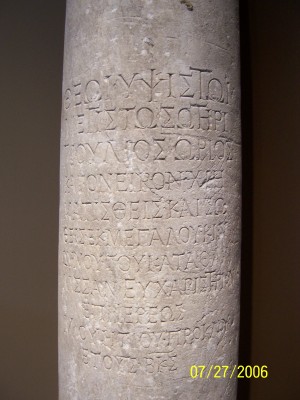|
The content on this website is maintained by
Robert Myallis, pastor at Zion's Lutheran Church, of Jonestown, PA.
The photos were taken by
Emily Myallis, a diaconal minister in the ELCA who also serves at Zion's Lutheran.
This website and travel to
Greece was made possible by a grant from the
Fund for Theological Education,
which provides grants to assist the education and formation of
Christian leaders from numerous denominations.
Bible quotes are taken from the New
Revised Standard Version, unless cites otherwise.
The above photo of Greece comes from
NASA; The icon of Saint Paul comes from George Mitrevski's website. |
 |
|
Most
High God Dedication
 This
pillar here records a "donor thanking the supreme God for
saving him from great danger by intervening through a
dream." The word supreme here is in the top time y-ps-i-s-t-oo. This
pillar here records a "donor thanking the supreme God for
saving him from great danger by intervening through a
dream." The word supreme here is in the top time y-ps-i-s-t-oo.
How is this pillar significant for
understanding the world of Paul?
As the number of gods continued to grow as more societies
brought their gods to Greece, people were starting to believe in
a God above all other Gods. This pillar indicates this. However,
other examples of this exist. The only Papryus
(ancient paper) found in Greece presents Zeus (the Greco-Roman
god of thunder and sky; Jupiter in Roman mythology) not simply
as one of the gods, but as the primary god, the originator of
all things.
The word for "supreme" found in the pillar is also
found in the New Testament to describe the Christian God.
- Paul says, "Yet the Most High does not dwell
in houses made with human hands..." (Acts, chapter
7:48).
- A slave-girl calls out to Paul, "These men are slaves
of the Most High God, who proclaim to you a way of
salvation." (Acts, chapter 16:17)
- A demon calls out to Jesus: "What have you to do with
me, Jesus, Son of the Most High God? I adjure you by
God, do not torment me." (Mark, chapter 5:7)
At some level, the very multiplicity of gods, which had
allowed Greek mythology to incorporate many stories and ideas
into the beliefs, began to crack under its own weight and the
idea that there was one ultimate God was beginning to grow. See
the Areopagus for more on
how Paul exploits this fact.
source:
pillar and info: placard at Thessaloniki
Archeological Museum, July 2006.
|
|



 This
pillar here records a "donor thanking the supreme God for
saving him from great danger by intervening through a
dream." The word supreme here is in the top time y-ps-i-s-t-oo.
This
pillar here records a "donor thanking the supreme God for
saving him from great danger by intervening through a
dream." The word supreme here is in the top time y-ps-i-s-t-oo.